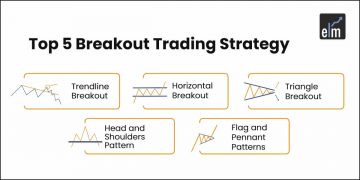A trend is a significant market state, so every trader must understand trends thoroughly. No trend lasts forever: there will always be a point at which the direction you are trading reverses, and a new trend begins. Technical analysis can tell a trader if a trend is about to change direction or confirm a trend reversal.
A trader needs to be aware of an impending reversal for two reasons. If a trader already has a position on a trend, they want to exit it before it reverses. Second, a reversal occurs when a new trend emerges. You can join if you correctly read the market and spot it quickly.
The likelihood of a reversal is heavily influenced by the strength of the current trend: if the trend is weak, the reversal is more likely. There are several methods for estimating the strength of a trend. We can suggest two approaches: visual analysis and technical indicators.
So, in today’s blog, let us discuss some methods that will help you identify trend reversals in stocks:
5 Tools to Spot Trend Reversals in Stocks
1. Visual Analysis
One should examine the highs and lows of a trend. The trend is strong if the corrections are brief and the consolidations form in narrow ranges. Price strictly respects the first support formed at the previous highs in a strong bullish trend:
During a slow uptrend, the price may fall below the previous high (the initial support) but remain above the previous low.
The presence of a lower high indicates a weak uptrend. Traders will be concerned about the formation of the “Head and shoulders” pattern and a potential market reversal to the downside in this situation.
Furthermore, if the price begins to revisit a support line too frequently, it indicates that the uptrend is weakening.
As the preceding explanations demonstrate, it is necessary to distinguish between support A (previous high during an uptrend) and support B. (previous low during an uptrend). When the price breaks support B, a reversal occurs, confirming that the price did indeed break below support/above resistance before declaring a reversal is critical. Examine the Japanese candlesticks carefully: the breakthrough candlestick should close below the support/above the resistance.
When the broken line is retested, but the price does not return above or below it, this is ideal. Technical indicators and volume may also confirm a breakthrough.
2. Moving Averages\Ichimoku
To begin with, Moving Averages of various periods can provide support/resistance levels beyond which traders will see a reversal or intersect, signaling a trend change.
The Ichimoku indicator also includes a set of lines that indicate when the market shifts from bullish to bearish and vice versa.
3. Average Directional Index
Second, ADX is a leading indicator of the strength of a trend. When the trend becomes stronger, the indicator’s main line rises. The ADX magnitude ranges between 0 and 100. The trend is distinct and strong if the indicator is greater than 25.
When the ADX rises above 25, it can be used to confirm a breakout and trend reversal. In addition, the two other lines of the indicator may indicate the direction of the reversal.
It’s also worth keeping an eye on how ADX is trending. If the indicator forms a series of higher peaks, the trend is strong, and a reversal is unlikely.
4. Volume Indicators
Volume indicators can also be used to estimate trend strength and confirm reversals. If a lower high was formed in an uptrend and volume was also lower, it is a strong indication of a reversal to the downside.
5. Sushi Roll Reversal Pattern
The term sushi roll candlestick pattern was first coined by the British writer Mark Fischer in ‘The Logical Trader’, a book he authored. Sushi Roll is a candlestick pattern comprised of ten bars.
The first five bars are called the inside bars because they are confined within a slim or narrow range of highs and lows. The remaining five bars, known as the outside bars, have lower lows and higher highs than the first five bars.
As a result, a pattern resembling a literal sushi roll is created. When the sushi roll pattern appears during a dominant trend, it indicates that a trend reversal is imminent. In many ways, this pattern is similar to bearish and bullish engulfing patterns. The main distinction here is that, instead of a pattern made up of two single bars, the sushi roll pattern is made up of several bars.
You can also watch our webinar in Smart reversal price action strategy
Bottomline
We hope you found this blog informative and use the information to its maximum potential in the practical world. Also, show some love by sharing this blog with your family and friends and helping us spread financial literacy
Frequently Asked Questions (FAQs)
How do you find the trend reversal of a stock?
Moving averages, trend lines, and other indicators can be used to spot trend reversals. Additionally, using support and resistance, breakouts, and pullbacks established on the chart, traders can trade trend reversals. During a transaction, accurate analysis and entry locations can aid traders in maintaining equilibrium.
How to identify trend reversal in Nifty?
Moving averages are employed to reduce price turbulence and spot patterns. When the short-term moving average crosses above or below the long-term moving average, a trend reversal is frequently suggested.
What are the indicators for stock price reversal?
However, if a stock’s price high is greater than its RSI high, this could indicate sluggish momentum and an oncoming reversal. On the other hand, if a stock records a lower price low but a higher RSI low, the downtrend might be ready to terminate.









